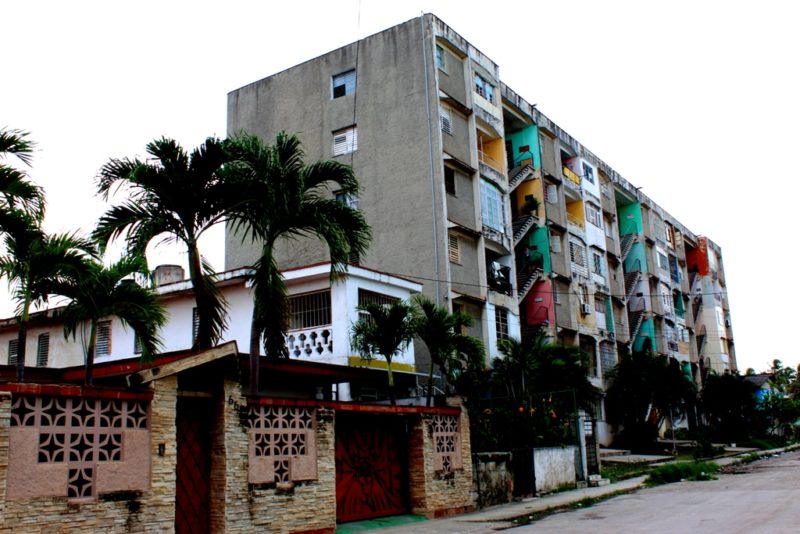Cuba’s Housing Brigade Projects of the 1970s and 1980s

Photo Feature by Ernesto Gonzalez Diaz
HAVANA TIMES – They are known as micro-brigade buildings because they were constructed by brigades made by a combination professional builders and the people who were going to live in them, that is, by their future residents. The so-called micro-brigade movement emerged in the 1970s to try to solve the growing and still unresolved housing problem in Cuba.
This movement was based on the release of workers needing housing from their workplaces with pay, to join the construction. Once the building was completed, an apartment was sold to the builder through a bank loan.
To speed up the construction of these buildings and reduce project costs, most were prefabricated buildings using the Gran Panel IV, V, E-14, E-15, and Sandino systems, systems that had been widely used with modifications in the former socialist countries of Eastern Europe, except for the Sandino system, which was entirely created in Cuba.
For many, they are not aesthetically pleasing or attractive, nor are the apartments large and comfortable, but the reality is that they somehow alleviated part of the housing problem in the country and especially in Havana, a problem that is among the most serious faced by the population.
The quality of these buildings, in general, cannot be said to be optimal due to many factors. However, today, with proper maintenance cycle and adequate repairs, they are still mostly functional. It is necessary to point out that the high price of construction materials, which are prohibitive for a large part of the population, make maintenance more difficult.






Hi Andy, your post was approved, and I just tried again, but it still doesn’t appear. we will be looking into the comments problem.
Yes it is true that these buildings are not aesthetically pleasing, and the excessive use of grey concrete in the tropical sun does not add to the ambiance. Further, some do not even use the principles of ‘natural ventilation’ as the old colonial houses in Havana, Trinidad, Santiago etc use to cool the properties at the hottest times. However, you have to ask yourself the question: why do many Cubans prefer to live in these properties rather than the old colonial ones?
The answer is very clear ~ they at least have running water, their own private bathroom, a lounge and two or more bedrooms. The crumbling colonial properties in the old cities are falling apart, are extremely unsanitary, and with shared toilets and wash rooms for multiple families in the same house.
Havana also has the awful Soviet style compound where the Russians built an awful grey complex off the Malecon driving towards Miramar. This could be an example from right out of Eastern Europe! Never the less I have seen even worse examples in New Orleans, especially in the housing projects in the Desire District, and they are even more run down, and riddled with drugs, gangs and serious crime, with garbage all over the place!
What is quite sad is seeing large blocks between cities that have been abandoned at the height of the ‘Special Period’, mere skeletons on the landscape following the collapse of the Soviet Union, a graphic indication of when the decline set in after the COMECON subsidies/money ran out!
Hi – I left a comment re: Cuba’s Housing Brigade Projects of the 1970s and 1980s
July 31, 2024. The instant reply was ‘awaiting moderation’.
Have my comments on this article been delisted?
I’m just curious.
Best Regards,
Andy Husain
Leicester, UK
Yes it is true that these buildings are not aesthetically pleasing, and the excessive use of grey concrete in the tropical sun does not add to the ambiance. Further, some do not even use the principles of ‘natural ventilation’ as the old colonial houses in Havana, Trinidad, Santiago etc use to cool the properties at the hottest times. However, you have to ask yourself the question: why do many Cubans prefer to live in these properties rather than the old colonial ones?
The answer is very clear ~ they at least have running water, their own private bathroom, a lounge and two or more bedrooms. The crumbling colonial properties in the old cities are falling apart, are extremely unsanitary, and with shared toilets and wash rooms for multiple families in the same house.
Havana also has the awful Soviet style compound where the Russians built an awful grey complex off the Malecon driving towards Miramar. This could be an example from right out of Eastern Europe! Never the less I have seen even worse examples in New Orleans, especially in the housing projects in the Desire District, and they are even more run down, and riddled with drugs, gangs and serious crime, with garbage all over the place!
What is quite sad is seeing large blocks between cities that have been abandoned at the height of the ‘Special Period’, mere skeletons on the landscape following the collapse of the Soviet Union, a graphic indication of when the decline set in after the COMECON subsidies/money ran out!